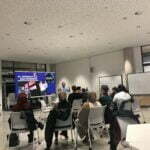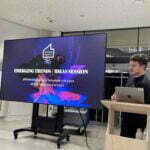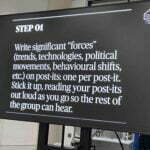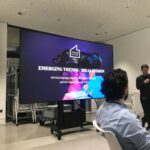Virtual Reality session. This is part of Mustafa Al-Adhami’s Lecture Series at Birmingham City University, where he leads the Emerging Digital Technologies module for Level 5 Architectural technology. This subject provides an in-depth examination of the integration of technology in the lifecycle of the building. The series aims to enlighten students and professionals about the latest advancements and their potential to shape the future of our built environment.
Session 0.1: Introduction to Emerging Digital Technologies in the Built Environment
Session 0.4: Digital Twin Practical
The virtual reality session held at STEAMhouse, Birmingham City University, provided students with an in-depth understanding of VR. The session covered the history of the technology, its rise and fall, followed by a deep dive into VR applications, particularly in the built environment. Harry Conway, Senior Technician – Immersive Media, and Milad, the Built Environment Technician, provided valuable assistance and support during the session.
The students were given the opportunity to gain hands-on experience with a range of VR applications, including Google Earth VR for site surveying, Gravity Sketch for basic design development, and Arkio VR collaboration. This interactive approach allowed students to apply theoretical knowledge to practical scenarios, enhancing their learning experience.
Finally, with the guidance and support of Harry, the students participated in an engaging activity to predict the future trends of technology in 2023. This activity encouraged students to think critically about the role of technology in society and its potential impact on various industries. Through this activity, students gained valuable insights into emerging technologies and the skills necessary to stay ahead in a constantly evolving digital landscape. Overall, the virtual reality session proved to be a valuable learning experience, providing students with the tools and knowledge necessary to excel in the field of VR and technology.

What is Virtual Reality (VR)?
The session starts with asking a question what Virtual Reality is.
Johnny English Strikes Again (2018)
Futurequest Virtual Reality (1994)
Statistics from my old session back to (2018 – 2019) students used virtual reality. Most of them used Google cardboard type, and even those who chose others were different forms of stereoscope VR based on smartphones

Virtual reality definitions
- Technical
Computer-generated simulation of a 3D image or environment that can be interacted with in a seemingly real or physical way by a person using special electronic equipment, such as a helmet with a screen inside or gloves fitted with sensors.

- Psychological
Meaning that VR is an emulation of a situation that humans can understand and perceive to be real.

Emulation and perception are the basic keys to describing Virtual Reality.
Human sensory and perception systems can process unreal data and convince the viewer to perceive it as reality. So if that is the definition of VR, then how old is VR?
How old is Virtual Reality (VR)?
To understand that, we can go back to Lascaux’s painting Montignac, France – 17,000 as they are some kind of creating an illusion!

Architects and artists they were always tried to create an illusion or play with our minds, such as Camera degli Sposi by Andrea Mantegna – 1474

If virtual reality is related to head-mounted display (HMD) devices, then we can say the first concept of virtual reality was in the Stereoscopic devices 19th century.

Other devices developed in the early twentieth century, such as:

Sensorama vr BY Morton Heilig 1962

Ivan Sutherland 1968 augmented reality headset to view a floating cube

Virtual Visual Environment Display (VIViD) in the 1980s

The term’ virtual reality was coined by Jaron Lanier in 1987

Virtuality Group 1991

CAVE Automation Virtual Environment (CAVE) system

Virtual Boy (1995)

Some movies and tv programs about VR in (the 1990s)
The Lawnmower Man 1992

Virtual Research Flight Helmet 1993
So what happened to Virtual reality?
Virtual Reality hype cycle
Hype cycle for emerging technologies

Gartner Hype Cycle Explained

High budget applications

Palmer Luckey (2009), A 16-year-old boy, began building VR headsets launched by Oculus VR in April 2012 and then bought by Facebook (Meta)

After two decades now, we have more advanced VR headsets cheaper than before. Many tools are easy and free to use to develop VR applications, such as Unity and unreal engines

Let’s look at the long nose of innovation and the hype cycle

Let’s look at the long nose of innovation and the hype cycle

You can read more from this conference paper
VR Experiences

VR Applications

VR applications in the Built environment
Construction simulation in VR

Laser scanning to VR

OTHER applications

Augmented Reality – Design Review – Urban Level

Augmented Reality for Design Review (Drone + BIM)
Augmented Reality for Quality Control

Summary
The virtual reality session at STEAMhouse, Birmingham City University, gave students a deep understanding of VR, including its history, rise and fall, and VR applications in the built environment. With support from Harry and Milad, the students gained hands-on experience with various VR applications and participated in an activity predicting future technology trends in 2023. The session enhanced their learning experience and provided valuable insights into emerging technologies and the skills necessary to excel in the field of VR and technology.






























